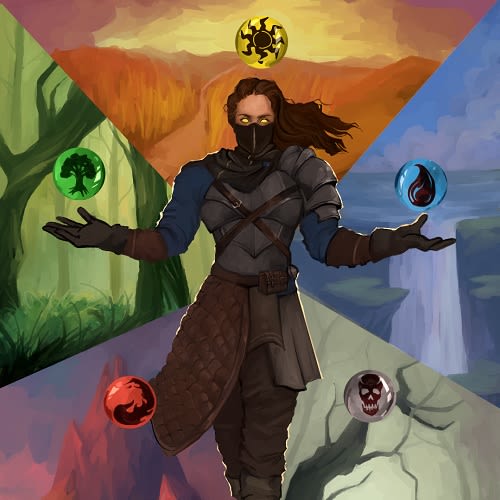I played Magic on Tuesday. For most people reading (or writing for) a site that’s somewhat targeted toward people who play Magic, this might not seem very notable. However, since I live in an area of upstate New York far removed from large tournaments, strong players, or any form of culture, competitive Magic is tough to find. Combine this with the fact that I work weekends in a lovely independent bookstore, and I can’t even drive half an hour to play Friday Night Magic in a rundown strip mall.
A savior approaches! Sanctioned Tuesday-night Drafts in some town I’ve never been to located forty minutes north of me! How this town has a large enough community for Magic is mysterious to me, since it’s backwater enough that Main Street is practically deserted at 6:30 P.M. (with plenty of street parking available), and the other Main Street that I go to first has houses on it. If your Main Street is residential, you’re not going to be a cultural center.
But if I live in an area where horses outnumber people, why don’t I play Magic Online? I should be. However, playing completely dead formats for an entire month when real life has an additional set is really depressing. The best explanation I have for this month-long delay is that local game stores were worried that Magic Online wasn’t a mediocre enough experience, so it had to have an additional handicap for game stores to have a more significant edge. If this is the thinking, they should stop worrying—Magic Online certainly isn’t anywhere close to being a threat to local game stores. It’s buggy and unstable, sure, but that’s not even the issue. The audience being targeted is completely different.
Magic is an inherently social game; the experience depends in huge part on who it’s being played with and in what situation. Drafting with a different crowd in a different store—even with the same cards—will feel entirely different. Magic Online is a completely isolated, dehumanizing way to play Magic, and the people who go to their game stores on a regular basis just aren’t interested in that. They want to hang out with their friends and talk about the cards—not sit in front of a computer while their opponent’s clock runs down. Magic Online’s audience are those few players who don’t mind all the social frills and overall play experience stripped from it.
The game store I went to compensated for its somewhat backwater location by being enormous. Its location was formerly occupied by two businesses, so the play area is separate (through an archway) from the store part of the store. The advantage of a rundown town is that real estate is staggeringly cheap. Each area goes back so far that, if it were rendered on a PlayStation, half the room would be covered in fog. A mural covers the wall when one walks in, its airbrushed-van aesthetic reminiscent of Douglas Shuler’s earlier work.
For all the flaws in Magic Online’s drafting and playing process, it’s fair. At local game stores, I can’t remember the last time I was placed in an eight-person pod and only played people from that pod. This time, I was at a six-person table in a thirteen-person Draft, so I would (most likely) play against people with significantly stronger decks. The player sitting across from me, who would be passing to me in pack two, was in that most intolerable phase of a Magic player’s trajectory: not good enough to properly evaluate cards, but fully aware of the rough financial value of certain cards—or at least what the most expensive card in any set is—and completely willing to loudly and repeatedly announce hopes of opening it. This is made worse by the fact that he vocally hopes to open Liliana in the first pack of Innistrad, then does so, showing everyone at this table and the adjacent one, saying how he’s definitely drafting black now (as he begins to pass cards to me).1
I don’t remember much about drafting when I was younger, which is probably for the best, since I have no doubt I was less tolerable than any player I’ve encountered in years. I first drafted around the age of ten, at a store called The Game Place that had a reasonable gang of quality players who all had moved on for one reason or another. At that time, it was almost entirely casual.2 When the other card store in town (The End, co-owned by Mike Long) closed temporarily, there was a bizarre collision of worlds when the competitive players from that store came over to The Game Place to draft on a Friday night. The two groups barely spoke except when they were required to for their matches.
The biggest lasting impact that The Game Place had on me was after I left Magic for a bit, and then came back one Friday night to play. They were playing board games because they didn’t play Magic anymore. I asked about that, and a former Magic player told me I couldn’t expect to leave a small game community and have it exist in the same way after that. The fact that a kid who wasn’t even very good could have that big of an impact floored me.
But back to the Draft. My first impression of Dark Ascension was opening the pack and seeing this as my double-faced card:
As a GoodGamery poster noted, an entire Women’s Studies thesis could be written about this card.
According to Steve Argyle, the main effect of being bitten by a vampire (other than transforming from as-strong-as-a-Grizzly-Bear to could-fight-various-kinds-of-Beasts/Wurms/Cyclopses/Minotaurs-and-live) is that it turns a sweet, innocent redhead into some sort of raven-haired titmonster.
Rosewater and others have defended Magic’s portrayal of women, saying it’s better than other fantasy/gaming/nerd portrayals, but that’s really not saying much.3 The fact that their main villain and their chief female character is basically fanservice is awful, and they get Steve Argyle to draw her—a man who sees Magic as his vehicle to draw incompetent erotica.
On to the set itself: Something I didn’t pick up on in time for my “full” Dark Ascension review is how much lower the power level of this set is. It’s very difficult to become excited for a new Limited format when the big change is that one of the packs has been replaced by a set that’s the same as the old one . . . except the cards aren’t as good. There’s nothing wrong with a new block shifting the power level of the game one way or another, but when a small set is this different in power from the previous set, it’s a bad sign. Usually, it’s the other way around: Alara Reborn was fun to see as the third pack because about half your deck would end up coming from that pack. But when the power goes down, players are going to notice, and they’ll think the games aren’t as fun just because they’re not doing as many powerful things as they were before the change. Unfortunately, this has to be seen as a development failure.
The sad thing is that after drafting this in person . . . I want to go back on Magic Online and do a bunch more triple-Innistrad while I still can.
1 My strategy going in, since it was a six-person Draft and I was being passed a pack from an inexperienced player, was to take decent cards and cast a bunch of 2-drops on my way to an easy 3–1 finish. Instead, I took some early red cards, then saw Faithless Looting and Secrets of the Dead, vowing to attempt that strategy if they came back on the quick wheel, which they did. I wouldn’t be completely screwed if the strategy didn’t pan out—I had a couple Wrack with Madness—but the deck wasn’t looking too hot until I lucked into a pack-three, sixth-pick Burning Vengeance.
The next three matches were some of the most straightforward I’ve played in Limited. Because I didn’t have to mulligan, I found an engine early, and my opponents didn’t get off to blazing starts, I won my first six games fairly handily. Most games came to a point at which my opponent had zero or one relevant creature while I had one or two, they were playing off the top, and I had five or six cards in hand. I’m sure I made a series of bad decisions with those mitts full of spells, but since the deck put me so far ahead, it never mattered in those games.
For the final match, I was paired against the undefeated player from the seven-person draft, who assembled a very good Spider Spawning deck with the standard assortment of Memory's Journey, Runic Repetition, Gnaw to the Bone, some defensive guys, flyers, and a couple Ghoulcaller's Bell. I mulliganed in both games, but even if I had started at eight cards, his deck was both more powerful than mine and a strategic trump, with creatures that suck to target with Burning Vengeance, late-game inevitability superior to mine, and the fact that he couldn’t even be decked unless I had Dream Twist in my hand when he had zero cards in his library.
For those of you who are looking for insight as to whether this deck can work in more serious circumstances: It’s possible. Secrets of the Dead is no Burning Vengeance. (For a literal example of this, there was at least one embarrassing point when I played the Secrets, flashed back a spell next turn, and pointed to the creature I wanted to deal 2 damage to before my opponent kindly pointed out that my enchantment was blue.) In the majority of situations in Limited, dealing 2 damage (especially when one’s mana is already tied up from flashing back a spell) is worth significantly more than a card. Since Dark Ascension is a small set, though, this means that the total number of Secrets plus Vengeances is going to be slightly higher than the number of Burning Vengeances the deck had in triple-Innistrad.
When it comes to the actual flashback spells, though, in addition to a few good flashback cards for which either the actual card or the flashback requires a splashed color, the deck gains Faithless Looting. This card gets to take the place of Dream Twist as a cheap enabler for one pack, and it’s absolutely wonderful. Even playing a “normal” game in which one doesn’t have the engine going yet, Faithless Looting more than overcomes its card disadvantage by ditching two cards of questionable usefulness for more immediate options. What pushes it to being even better is that, as Zac Hill noted, every spell with flashback has the secret invisible text, “Draw a card,” attached to the main part of the spell, with the caveat that the card you draw is always the card you cast at its flashback cost. Since the card is usually being played in a control-style deck that can stall the board out pretty well, it’s not difficult to find the 3 mana to take full advantage of the card.
2 This is diplomatic to the point of deception. What I mean is that no one at the store was very good. While I was “casual” for the reason that I had very little idea how to effectively win games, there’s no doubt in my mind that, with proper instruction from someone better at Magic, I would have turned into the dreaded hyper-competitive twelve-year-old.
Casual players (including my esteemed editor) should shield their eyes here. It’s well-known that many casual players think of competitive players as unfun, uptight, uncreative assholes, and that competitive players think of casual players as completely incompetent at playing Magic. For the former straw man, I would say that competitive players have fun in a different way (specifically: from the mental challenge created by two players with an earnest desire to win and the mental puzzles the players have to solve to do so), and they make decks that are just as creative (if not more so) than the decks a casual player would put together. The difference is that, when they make something highly outside-the-box and it works well, it’s treated as “just another dumb deck that wins,” when really, it took significant breaks from conventional thinking to make a ten-land aggro-control deck or creature-based combo deck that played four colors and relied almost exclusively on the graveyard. The difference is that, when these players come up with some bizarre-but-cool-sounding strategy that doesn’t end up working—such as drafting a deck based around Manalith in M12—the world never hears about it. Casual players don’t have that filter that suppresses the out-there designs that aren’t effective.
But then we get to casual players. There’s no way to put this nicely. The vast majority of them—unless they are former competitive players who went through some sort of twelve-step program to guide them away from the evils of PTQs and toward the light of Commander—would not be able to play a game “correctly” with a metaphorical gun to their heads (a metaphorical gun does not give one the sinking feeling of, “Oh God, someone is holding a gun to my head,” with the ensuing panic and fleeting thoughts about the bizarreness of someone holding a literal gun during a game of Magic . . . I just mean, “If they tried their very bestest”). Yes, I know the argument that casual players don’t want to necessarily make the play that will have the highest chance of him winning, or other things like that, but from watching them play, I doubt that they could make that play at all. Further, a lot of players become grouped into the casual category when they, as I did at an early age, are trying their hardest to win, but because they don’t know exactly how to go about that, they give off the impression that they must not be trying.
3 See: Batman: Arkham City. Playing as Catwoman is great. But the full-body pan it does of her every time she appears in a cut scene and the fact that every word out of her mouth consists of her flirting with a male character (even the one who has her tied up over a vat of acid)? Not so much. And because skintight leather wasn’t enough, she has to have skintight leather unzipped at her cleavage. Yet it’s still skintight . . . despite being unzipped. The message being sent is: Women can be cool superheroes, too! But don’t you ever forget that your sexual appeal is way more important.


























